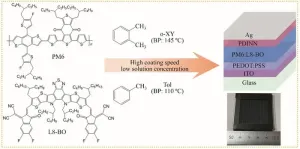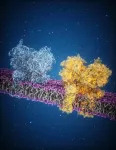(Press-News.org) In a recent advancement, researchers have developed a high-speed doctor-blading technique that enhances the efficiency of organic solar cells (OSCs) while using eco-friendly, non-halogenated solvents. This innovative method not only addresses the environmental and scalability challenges of traditional solvents, such as chloroform, but also achieves impressive power conversion efficiencies (PCEs) of 18.20% and 17.36% with green solvents like o-xylene and toluene, respectively. With a module efficiency of 16.07%, this breakthrough sets the stage for more sustainable, large-scale manufacturing of OSCs.
Organic solar cells (OSCs) are hailed for their lightweight, flexible design and their potential for low-cost, roll-to-roll production. However, the widespread use of halogenated solvents, including chloroform, has raised concerns due to their environmental and health hazards. These solvents also limit scalability, as they require high concentrations and narrow processing windows that complicate large-scale production. While non-halogenated green solvents have been considered a safer alternative, their lower solubility and suboptimal film morphology have historically hindered device performance. This has created a significant need for new fabrication methods that can optimize green solvents without sacrificing efficiency.
Published (DOI: 10.1007/s11771-024-5718-0) on January 30, 2025, in the Journal of Central South University, a research team introduced a game-changing high-speed doctor-blading method that overcomes these challenges. The technique reduces the necessary solution concentration for OSCs, enabling the use of environmentally friendly solvents like o-xylene and toluene without compromising efficiency. The team demonstrated a remarkable module efficiency of 16.07% using o-xylene, showcasing the potential for greener, scalable OSC production.
By employing the high-speed doctor-blading technique at 70 mm/s, the researchers reduced the solution concentration to just 8.8 mg/mL—significantly lower than the 15.4 mg/mL required for traditional spin coating methods. This allowed the use of non-halogenated solvents, which are more environmentally sustainable. The results were striking, with the o-xylene-processed devices achieving a PCE of 18.20%, surpassing the 17.36% efficiency of toluene-processed devices. The longer liquid-to-solid transition time of 6 seconds with o-xylene, compared to just 1.7 seconds with toluene, played a critical role in enhancing film crystallinity, reducing defects, and boosting carrier mobility. Morphological analysis confirmed that o-xylene-processed films exhibited superior molecular packing and crystallinity, further contributing to the higher efficiency. Additionally, the scalability of the technique was demonstrated with the successful achievement of a module efficiency of 16.07%.
Dr. Jun-liang Yang, the corresponding author of the study, emphasized the significance of the team's findings. "This study represents a significant leap forward in the field of organic photovoltaics," he said. "By developing a high-speed doctor-blading technique that works with non-halogenated solvents, we have not only improved the efficiency of organic solar cells but also made them more environmentally sustainable and scalable for industrial applications."
The development of this high-speed doctor-blading technique offers a promising solution for the mass production of organic solar cells using green solvents, addressing both environmental concerns and scalability challenges. This innovation has the potential to significantly reduce the carbon footprint of solar cell manufacturing while maintaining high efficiency. With module efficiencies exceeding 16% using non-halogenated solvents, this technology holds great promise for a variety of commercial applications, including flexible, lightweight solar panels for portable electronics, building-integrated photovoltaics, and large-scale solar farms. This research highlights the role of green solvents in advancing renewable energy technologies and driving a more sustainable energy future.
###
References
DOI
10.1007/s11771-024-5718-0
Original Source URL
https://doi.org/10.1007/s11771-024-5718-0
Funding Information
Project(2022YFB3803300) supported by the National Key Research and Development Program of China; Projects (U23A20138, 52173192) supported by the National Natural Science Foundation of China; Project(GZC20233148) supported by the Postdoctoral Fellowship Program of CPSF, China; Project(140050043) supported by the Central South University Postdoctoral Research Funding, China.
About Journal of Central South University
Journal of Central South University publishes original academic papers representing the latest research in various engineering fields. The Journal mainly publishes original academic papers which represent the latest research achievements in such fields as materials science and engineering, metallurgical science and engineering, mineral processing, geology and mining, chemical engineering, and mechanical, electronic and information engineering.
END
Green solvent innovation: high-speed doctor-blading boosts organic solar cell efficiency
2025-03-28
ELSE PRESS RELEASES FROM THIS DATE:
C-Path announces successful conclusion of the ECOA: getting better together initiative
2025-03-28
TUCSON, Ariz., March 26, 2025 – Critical Path Institute® (C-Path)Patient-Reported Outcome (PRO) Consortium and Electronic Clinical Outcome Assessment (eCOA) Consortium are pleased to announce the successful conclusion of the eCOA: Getting Better Together Initiative. This initiative, driven by a shared commitment to advancing patient-focused drug development, has culminated in meaningful, lasting changes that will benefit all stakeholders across the eCOA ecosystem.
Beginning in 2019, this C-Path-led collaborative, pre-competitive initiative brought ...
Brain channels ‘stopped in time’ reveal chemical flow that enables learning and thinking
2025-03-28
FOR IMMEDIATE RELEASE
In an effort to understand how brain cells exchange chemical messages, scientists say they have successfully used a highly specialized microscope to capture more precise details of how one of the most common signaling molecules, glutamate, opens a channel and allows a flood of charged particles to enter. The finding, which resulted from a study led by Johns Hopkins Medicine researchers, could advance the development of new drugs that block or open such signaling channels to treat conditions as varied as epilepsy and some intellectual disorders.
A report on the experiments, funded by the National ...
PET imaging confirms direct involvement of dopamine in cognitive flexibility
2025-03-28
Reston, VA (March 16, 2025)—For the first time, scientists have confirmed a neurobiochemical link between dopamine and cognitive flexibility, according to new research published in the March issue of The Journal of Nuclear Medicine. PET imaging shows that the brain increases dopamine production when completing cognitively demanding tasks, and that the more dopamine released, the more efficiently the tasks are completed. Armed with this information, physicians may soon be able to develop more precise treatment strategies for neurological and psychiatric disorders.
Cognitive flexibility is the ability to adapt one’s thinking and behavior appropriately to ...
Understanding the immune response to a persistent pathogen
2025-03-28
Most humans have long-lived infections in various tissues—including in the nervous system—that typically do not result in disease. The microbes associated with these infections enter a latent stage during which they quietly hide in cells, playing the long game to evade capture and ensure their own survival. But a lack of natural models to study these quiescent stages has led to gaps in scientists’ understanding of how latency contributes to pathogen persistence and whether these stages can be targeted by the immune system.
Now, a team led by University of Pennsylvania School of Veterinary Medicine researchers ...
GSA conducting April 1 congressional briefing on impact of obesity as we age
2025-03-28
The Gerontological Society of America (GSA) invites you to a congressional briefing:
Title: The Impact of Obesity and Opportunity for CMS to Address
When: Tuesday, April 1, from 12 to 1 p.m. ET
Where: Virtual
Click to RSVP
GSA is a professional membership organization committed to promoting the best available interdisciplinary aging research to advance innovations in practice and policy. This is especially key to managing the chronic condition of obesity in health care.
Older people with obesity and overweight require access to proven treatment options and care to improve overall health and reduce other related health care costs. ...
Professor receives pilot funding to conduct study to increase forest farming in Appalachia
2025-03-28
Appalachia is globally recognized as a key supplier of non-timber forest products (NTFPs) with growing demand for its resources. Nearly half of the woodland medicinal species in the global nutraceutical market come from the region, contributing to a multibillion-dollar industry.
Species such as ginseng, slippery elm, and black cohosh are prominent understory sources of medicinal material. Appalachian edible products are also gaining popularity beyond the region. Ramps, a wild Appalachian plant, can sell for more than $20 per pound in places such as New York City.
Spanning 205,000 square miles, Appalachia is home to over ...
New PET radiotracer provides first look at inflammation biomarker in the human brain
2025-03-28
Reston, VA (March 28, 2025)—A novel PET imaging approach can effectively quantify a key enzyme associated with brain inflammation, according to research published in the March issue of The Journal of Nuclear Medicine. The first-in-human study, which imaged the COX-2 enzyme, offers a never-before-seen view of inflammation in the brain, opening the door for COX-2 PET imaging to be used in clinical and research settings for various brain disorders.
COX-2 is an enzyme in the brain that can be markedly upregulated by inflammatory stimuli and neuroexcitation. Researchers say that the density of COX-2 in the brain may be a biomarker and effect of inflammation, ...
Genes may influence our enjoyment of music
2025-03-28
Music is central to human emotion and culture. Does our ability to enjoy music have a biological basis? A genetic twin study, published in Nature Communications, shows that music enjoyment is partly heritable. An international team led by scientists from the Max Planck Institute for Psycholinguistics in Nijmegen, the Netherlands, uncovered genetic factors that influence the degree of music enjoyment, which were partly distinct from genes influencing general enjoyment of rewarding experiences or musical ability.
Music plays an important role in human emotion, social bonding, and cultural expression. As Darwin already noted, music "must ...
Global patterns in seed plant distribution over millions of years
2025-03-28
Why do some plants thrive in specific regions but not in others? A study led by researchers at the University of Göttingen explores the factors shaping plant distributions and how these patterns have changed over millions of years. Analyzing nearly 270,000 seed plant species worldwide, the research highlights the roles of environmental conditions and dispersal barriers in influencing global plant diversity. The results were published in Nature Ecology & Evolution.
Using advanced methods that integrate plant distributions with phylogenetic information – meaning data about the evolutionary relationships among plant species – researchers ...
Fatty acids promote immune suppression and therapy resistance in triple negative breast cancer
2025-03-28
HOUSTON – (March 28, 2025) – A new study published in the journal Immunity reveals a mechanism that allows triple negative breast cancer (TNBC) to develop resistance to therapy. Researchers at Baylor College of Medicine showed that lipid accumulation in tumor cells and nearby immune cells promotes immune suppression, but disrupting lipid formulation reverses treatment resistance and the immunosuppressive microenvironment.
Standard-of-care treatment for TNBC includes chemotherapy and immunotherapy. However, some initially responsive tumors still develop recurrences. Researchers studied mouse models and found that TNBC cells that survived treatment accumulated ...





